
Professor Maria Jaschok FGCA has been elected as Chair of the Global China Academy Board of Trustees
The Global China Academy (GCA) is pleased to announce that Professor Maria H.A. Jaschok has been elected as the new Chair of the Board of Trustees. This appointment, made on 23rd February 2024 during the GCA Board of Trustees meeting, signifies an important moment for the Academy 2.0. With Professor Jaschok taking on the role of Chair, the Academy looks forward to leveraging her considerable experience and expertise. Her leadership is anticipated to contribute to the Academy’s ongoing efforts to promote academic and cultural exchanges, thereby deepening the understanding and cooperation between China and the global society. Professor Jaschok’s rich research background and dedication to interdisciplinary studies position her well to lead the Academy into its next stage of growth.
About the new chair
Professor Maria H.A. Jaschok 叶玛丽教授 (PhD, London/SOAS) is a Life Fellow of the Global China Academy. Currently, she is a Senior Research Associate in Contemporary China Studies at OSGA and serves as a Supervisor and Tutor for the MSt in Women’s, Gender, and Sexuality Studies at the University of Oxford. Most recently, she held a Visiting Professorship at King’s College, London, from 2019 to 2021. She was also the Director of the International Gender Studies Centre at Lady Margaret Hall from 2000 to 2018.
Her research interests are in the areas of gendered constructions of memory; feminist and aural ethnography; innovative research methodologies and uses of oral history in the writing of women’s history in Asian contexts. Long years of close research partnerships and friendships in the field engendered interest in feminist theorizing and ethnographic methodology and led to writing on collaborative modes of cross-cultural research and authorship. She is a member of many international academic and professional organizations, serving on steering committees, editorial and advisory boards.
See more about Professor Maria Jaschok on her webpage at the University of Oxford website: https://www.ox.ac.uk/news-and-events/find-an-expert/professor-maria-jaschok.
Recent publication

Professor Maria Jaschok is co-editer of the book Ethnographies of Islam in China (2021). In the late 1970s Islam regained its force by generating novel forms of piety and forging new paths in politics throughout the world, including China. The Islamic revival in China, which came to fruition in the 2000s and the 2010s, prompted increases in government suppression but also intriguing resonances with the broader Muslim world – from influential theoretical and political contestations over Muslim women’s status, the popularization of mass media and the appearance of new patterns of consumption, to increases in transnational Muslim migration. Although China does not belong to the ‘Islamic world’ as it is conventionally understood, China’s Muslims have strengthened and expanded their global connections and impact. Such significant shifts in Chinese Muslim life have received scant scholarly attention until now. With contributions from a wide variety of scholars – all sharing a commitment to the value of the ethnographic approach – this volume provides the first comprehensive account of China’s Islamic revival since the 1980s as the country struggled to recover from the wreckage of the Cultural Revolution.
The authors show the multifarious nature of China’s Islam revival, which defies any reductive portrayal that paints it as a unified development motivated by a common ideology, and demonstrate how it was embedded in China’s broader economic transition. Most importantly, they trace the historical genealogies and sociopolitical conditions that undergird the crackdown on Muslim life across China, confronting head-on the difficulties of working with Muslims – Uyghur Muslims in particular – at a time of intense religious oppression, intellectual censorship, and intrusive surveillance technology. With chapters on both Hui and Uyghur Muslims, this book also traverses boundaries that often separate studies of these two groups, and illustrates with great clarity the value of disciplinary and methodological border-crossing. As such Ethnographies of Islam in China will be essential reading for those interested in Islam’s complexity in contemporary China and its broader relevance to the Muslim world and the changing nature of Chinese society seen through the prism of religion.
Recent activities

Professor Maria Jaschok chaired the Reception at the 10th Global China Academy anniversary celebration in conjunction with the conclusion of the 8th Global China Dialogue (GCD8) at the Lords of the House in the UK Parliament on 8th December 2023. At the reception, the launch of the Global China Academy and Global Century Press‘s two new websites was announced and briefly introduced by Professor Xiangqun Chang 常向群教授 FRSA FGCA, President of the Global China Academy; Honorary Professor at University College London (2015-2020); and Distinguished Professor at Nankai University, China.
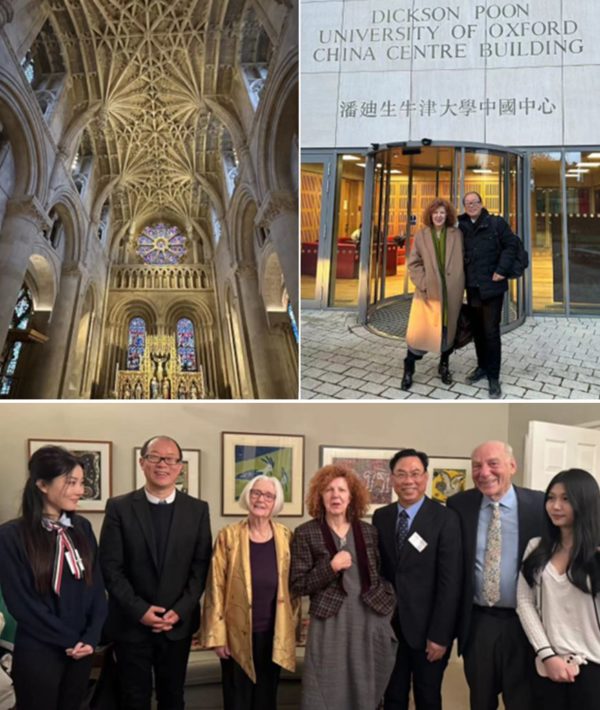
During the 8th Global China Dialogue (GCD 8), Professor Maria Jaschok, along with speakers and volunteers from GCD 8, visited the university campus and enjoyed tea at the home of Professor Robin Cohen FGCA. The top two photos show Professor Li Xuelin FGCA, an architect, and Professor Jaschok, an anthropologist, engaging in dialogues, enjoying the rich history, beautiful architecture, and academic excellence of the place. They also visited the Dickson Poon University of Oxford China Centre together. The photo at the bottom shows GCA Fellows, speakers of GCD 8, and volunteers with Professor Robin Cohen and his wife Selina Cohen at their home. They enjoyed tea together and had a lively exchange and conversation. Click here to view more details.
Professor Jaschok’s selection reflects the Board of Trustees’ confidence in her ability to steer the Academy towards fulfilling its objectives with a commitment to maintaining high standards and fostering innovation.The Global China Academy looks forward to the invaluable insights and leadership Professor Jaschok will bring to her role as Chair of the Board of Trustees, steering the Academy towards new heights of academic excellence and global impact.

Chinese New Year Greetings and Global China Academy Annual Report for 2023
Dear colleagues and friends,
As the Year of the Dragon 2024 ‘prowls’ forward, it is our pleasure to take this opportunity to update you on our situation and activities.
First, we would like to inform you that, at the end of 2023, we submitted our first annual return for the Global China Academy (GCA; CIO registered with the Charity Commission for England and Wales on 17th May 2022 with the number 1198983). In order to maintain a complete record for the previously registered charity (registered on 19th November 2013 with the number 1154640), covering the period from 1st April 2022 to 31st March 2023, we submitted the last annual return to the Charity Commission. This account is expected to be closed by the end of 2024.
This report highlights our achievements in three main sections: ‘GCA and GCP new websites’, ‘GCA activities fulfilling its academic and social missions’ and ‘The 8th GCD plus 10th GCA anniversary’.
Part I: Global China Academy’s virtual sties and GCA Centre / Fellows’ home
Part II: Global China Academy Activities on Academic and Social Missions
Part III: The 8th Global China Dialogue and the 10th Anniversary of GCA
- The 8th Global China Dialogue
- The Global China Academy’s 10th Anniversary
Click here to download 2023 report (Special Edition for the 10th GCA Anniversary: 2013–2023) .
- Click here to visit the Chinese New Year Greetings and the GCA Annual Report for the year 2021–2022. Download report.
- Click here to visit the Chinese New Year Greetings for 2022.
- Click here to visit Chinese New Year Greetings and the GCA Annual Report for the year 2020–2021. Download report.
- Click here to visit Chinese New Year Greetings and the GCI Annual Report for the year 2019–2020. Download report.
- Click here to visit Chinese New Year Greetings and the GCI Annual Report for 2018–2019. Download report.
- Click here to visit Chinese New Year Greetings and the GCI Annual Report for 2017–2018. Download report.
- Click here to visit Chinese New Year Greetings and the GCI Annual Report 2016–2017. Download report.
- Click here to visit Chinese New Year Greetings and the CCPN Global Annual Report for 2015–2016. Download report.
- Click here to visit Chinese New Year Greetings and the CCPN Global Annual Report for 2014–2015. Download report.
- Click here to visit Chinese New Year Greetings and the CCPN Global Annual Report for 2013–2014. Download report.
Note: The early greeting newsletters and annual reports contain a large number of web links to the old website. These will be available after being updated.
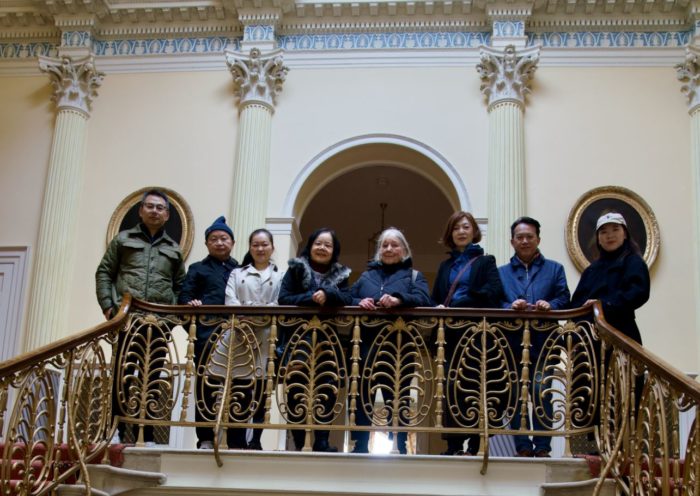
GCA’s Two-Day Team Building: Blending Academic Insight with Cultural, Historic and Nature Discovery, February 2024
After the intensive preparations and the successful hosting of the 8th Global China Dialogue and the 10th anniversary celebration of the Global China Academy, we decided to schedule the team-building activities for early February 2024. Our team consists of the following members: Xiangqun Chang (GCA President), Alan Fang (Legal Adviser), Katie Zheng (Administrative Manager), David Liu (Domestic Manager), LI Li, and Xi Shen (GCA8 Volunteers).
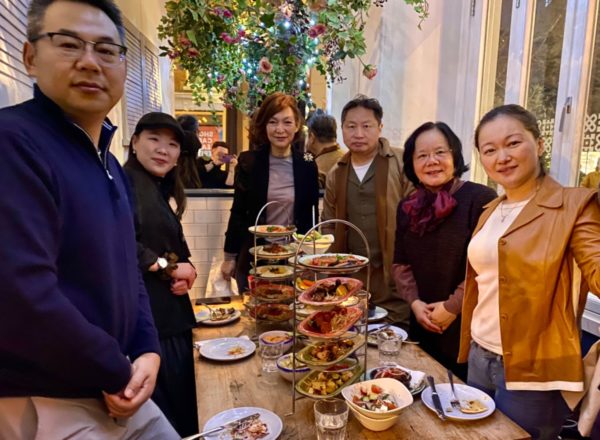
The first day of GCA’s two-day team-building event was scheduled for February 3rd, a time when people usually look forward to Chinese New Year celebrations. However, our team of six broke with convention and chose The Real Greek in Covent Garden for a culinary exploration. The restaurant was adorned with delicate flowers, adding a touch of Greek aesthetic that is quite different from the bold reds and golds of Chinese celebrations. The Mediterranean ambiance provided a fresh contrast to the red lanterns and decorations typical of Chinese New Year. The food was presented on tiered trays, a vibrant arrangement that stood in contrast to the communal style of Chinese dining where dishes are usually placed in the center of the table for everyone to share.
We ordered Greek Flatbread and Crudités, as well as a variety of dishes including Yellow Fava, Hummus, Tzatziki, Spicy Feta Dip (Htipiti), Melitzanosalata, Chicken Skewer, Loukaniko Beef & Pork Sausage Skewer, Pork Skewer, Halloumi & Vegetable Skewer, Lamb Meatballs, Gigandes with Spinach, Falafel, Grilled Aubergine, Vegan Meatballs, along with shared sides such as Mediterranean Rice, Aegean Slaw, Chips, Pourgouri – Bulgur Wheat, New Potatoes, and Greek Salad. For dessert, we shared Baklava, Orange Cake, and Greek Yogurt with walnuts in syrup.
The flavours of these dishes were diverse and rich, ranging from the refreshing tzatziki to the mildly spicy feta cheese dip, each bite filled with surprise. The smoky taste of the grilled aubergine offered a contrast to the commonly sweet and spicy flavours found in Chinese cuisine, while the falafel, with its crunchy exterior and soft interior coupled with a deep spice flavour, presented a completely different taste from traditional Chinese spring rolls. The various skewers we provided, including chicken, mixed meat sausage, pork, and halloumi cheese with vegetable skewers, were similar to Chinese lamb, grilled fish, and beef skewers, all involving grilling meat or other ingredients on bamboo or metal sticks. However, Greek skewers emphasized the use of herbs and olive oil in their flavours, while Chinese barbecue tends to favour seasonings like cumin and chili to enhance the flavour. The Mediterranean rice and Greek salad brought a refreshing taste that was a sharp contrast to the familiar Chinese rice and mixed vegetable dishes. The sweetness of the baklava and the soft, fluffy texture of the orange cake were delightful complements to Chinese festive sweets.
Through these various flavours and styles, our team not only enjoyed the unique charm of Greek cuisine but also deepened our understanding and appreciation of the differences between Western and Chinese culinary cultures. This visual and culinary journey not only provided a necessary break from our hard work in preparing for both the 8th GCD and 10th anniversary of GCA but also acted as a cultural bridge, connecting our team with the diverse traditions of the world. The shared Greek Flatbread and Crudités, the variety of dips and skewers, and the assortment of sides and desserts provided a communal experience that, although different in presentation, reflected the collective joy found in Chinese dining traditions. This experience was both a cultural immersion and a testament to the universal language of food in bringing people together.
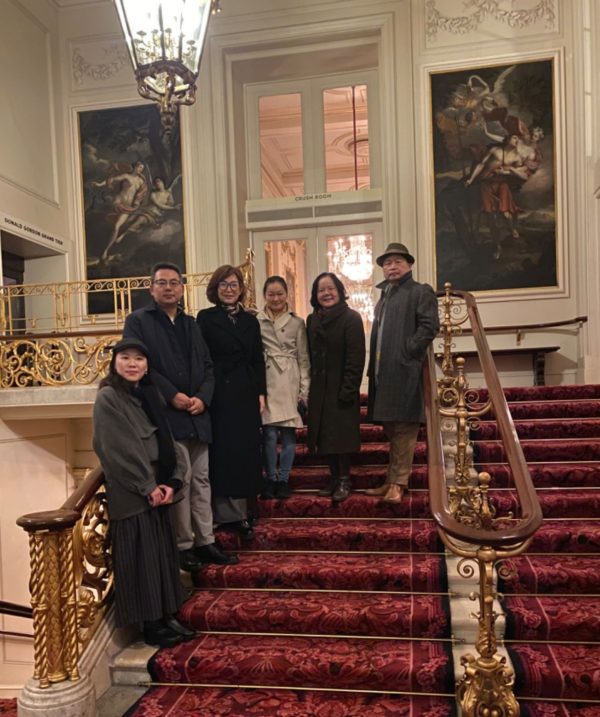
After enjoying a Greek dinner, our team went to the Royal Opera House to watch the ballet Manon. The Royal Opera House, located in London’s Covent Garden, is one of the world’s leading opera houses, renowned for its outstanding opera and ballet performances. It serves as the home of The Royal Opera, The Royal Ballet, and the Orchestra of the Royal Opera House. The building itself is a masterpiece of Victorian architecture, featuring a magnificent auditorium, luxurious public spaces, and state-of-the-art stage facilities. Its history dates back to the 18th century, making it a historic landmark and cultural icon in the UK. Manon is a three-act ballet created by Kenneth MacMillan, with music by Jules Massenet. It premiered by The Royal Ballet in London in 1974. The ballet is based on the 1731 novel The Story of the Chevalier des Grieux and Manon Lescaut by Abbé Prévost. It tells the story of the young and naive Manon who falls in love with the Chevalier des Grieux but is persuaded by her brother to leave him for the wealthier Monsieur GM. The ballet is known for its expressive choreography, emotional depth, and beautiful music, showcasing the talent and technical skills of its dancers. Manon and the Royal Opera House represent the pinnacle of Western classical performing arts, focusing on storytelling through dance, music, and set design.
In contrast, the Chinese equivalent in the realm of traditional performing arts can be considered Peking Opera or Kunqu Opera. Peking Opera and Kunqu Opera embody the essence of Eastern performing arts traditions, emphasizing vocal performance, poetic dialogue, and symbolic gestures. The main difference lies in the cultural expressions and artistic mediums used to convey stories and emotions. Western ballets like Manon typically use the universal language of dance to narrate stories, while Chinese operas incorporate a more integrated approach, combining singing, acting, and martial arts to express complex narratives and characters. However, both offer deep insights into their respective cultures and traditions, showcasing the universal appeal of storytelling through performing arts. Peking Opera is one of the most famous traditional Chinese theater arts, characterized by its unique combination of song, spoken dialogue, and codified action sequences, including gestures, movement, fighting, and acrobatics. It is known for its elaborate costumes, makeup, and the distinctive vocal style of its performers. Kunqu Opera is considered one of the oldest forms of Chinese opera, celebrated for its elegant movements, refined music, and literary excellence. Both forms of Chinese opera have deep historical roots and play a significant role in China’s cultural heritage, similar to the role of ballet and opera in Western cultures.
After watching Manon at the Royal Opera House, we were deeply moved and filled with a sense of appreciation and emotion. The performance in one of the most prestigious classical art venues was an unforgettable experience that resonated with us deeply. The dancers’ exquisite skills, coupled with the thrilling music and the poignant narrative of love and tragedy, transported us into the world of Manon and Des Grieux, allowing us to experience their joy, love, and despair firsthand. The choreography’s blend of classical ballet with richly expressive dramatic movements captured the complex emotions of the characters and the dramatic turns of the story. The grandeur of the Royal Opera House and the production’s lavish costumes and sets added an extra layer of enchantment to the evening, making us feel as though we were part of the opulent world depicted on stage.
This experience was not only an artistic delight but also a cultural enrichment, reminding us of the power of performing arts to evoke deep feelings and connect with audiences profoundly. As we left the opera house, we were in awe of the talent and hard work of the performers and creative team, yet also left with a lingering melancholy from the ballet’s tragic ending. Most importantly, we were grateful for the opportunity to witness such a masterful ballet display, which entertained and emotionally moved us, leaving a lasting impression on our hearts and minds.
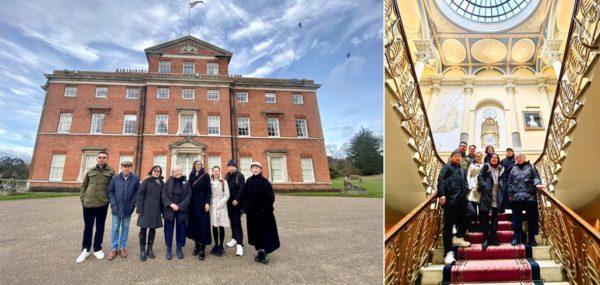
Day two, February 4th, our team visited Brocket Hall. We had the privilege of being accompanied by Dr Frances Wood, a historian and sinologist who previously served as the curator of the Chinese Collection at the British Library and is a trustee of the Global China Academy, as well as Dr James Lin, the curator of the Asian art collection at the Fitzwilliam Museum, University of Cambridge. Guided by their knowledge and insights, we toured almost every room in the estate, closely examining the furniture, paintings, and various collections. Afterwards, we walked through the lush fields, beside the lake and trees along the bridge.
Brocket Hall, located in Hertfordshire, England, is a classic English country house with centuries of history. The architecture of Brocket Hall is an excellent example of the Palladian style, characterized by symmetry, classical forms, and grand scale. The interior of the estate is equally impressive, with elegantly decorated rooms reflecting the era’s grace and luxury. This magnificent estate was once the residence of two British Prime Ministers, Lord Melbourne and Lord Palmerston, marking it as a site of significant historical and political importance. We explored almost every room, such as the bedroom of Queen Victoria, Lord Melbourne, Lady Melbourne, Lord Palmerston, Lady Palmerston, with each room narrating the stories of its past occupants and their times. Brocket Hall is renowned for its stunning architecture, extensive grounds, and its role in British social and political history.
Lord Palmerston served as the British Prime Minister during the First Opium War and was the Foreign Secretary at that time, playing a significant role in initiating and managing the conflict. He supported the use of force to protect Britain’s opium trade interests and advocated for a tough stance against China, leading to the outbreak of the conflict. The war ended with China’s defeat and the signing of the Treaty of Nanjing, which forced China to cede Hong Kong to Britain and open several trading ports, having a long-term negative impact on China. Palmerston’s policies expanded Britain’s global influence but also marked the beginning of a humiliating period in modern Chinese history, having profound effects on both China and world history.
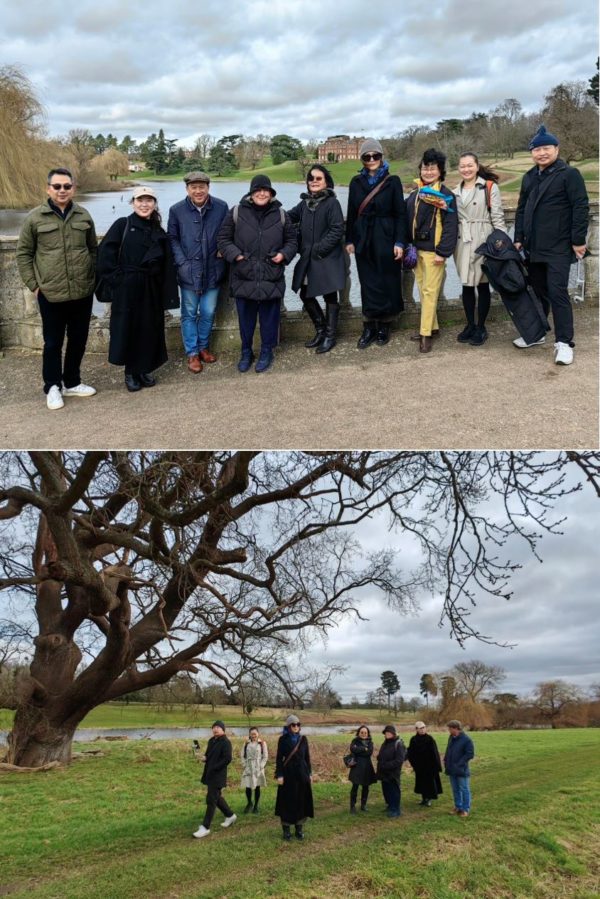
The gardens of the estate are a testament to the British tradition of landscape gardening, featuring expansive fields, neatly trimmed lawns, and mature trees, all set against the backdrop of picturesque lakes and bridges. This landscape provides a tranquil and pastoral setting where one can enjoy leisurely strolls and the natural beauty of the English countryside. This land and lake later became home to two golf courses, named after Lord Melbourne and Lord Palmerston, the two British Prime Ministers.
The horticulture and history of Brocket Hall can be compared to those of classical Chinese estates, which are typically designed according to Feng Shui principles to harmoniously integrate architecture, gardens, and water elements. Similar to Brocket Hall, these estates were once residences of high-ranking officials and centers of cultural and political activity. Classical Chinese gardens, such as those in Suzhou, are famous for their intricate designs that include pavilions, ponds, rockeries, and meticulously arranged plants, creating serene landscapes that reflect the philosophical and aesthetic ideals of traditional Chinese culture.
Brocket Hall embodies the heritage of English country estates, symbolizing political history and architectural beauty, while China’s classical estates represent the Eastern philosophy of harmony between man and nature, showcasing the art of garden design and the integration of indoor and outdoor spaces. Both traditions provide us with a window into their respective cultures, emphasizing the importance of history, nature, and architecture in shaping the identity and legacy of these remarkable estates.
During our visit to Brocket Hall, we deeply felt the profoundness of British history and the significant role these historical figures and locations played in world history. The explanations provided by Dr Frances Wood and Dr James Lin not only gave us a deeper understanding of the Hall’s history and architectural style but also offered a comprehensive view of Lord Palmerston’s role in the First Opium War and its impact on Sino-British relations. This journey was not only a visual and intellectual pleasure but also an opportunity for deep reflection and understanding of past events.
The natural beauty and tranquil atmosphere of the estate momentarily took us away from the hustle and bustle of modern life, as if we were transported back to an era filled with historical stories. Walking through the expansive fields and beside the lake, we couldn’t help but ponder the course of history and how it has shaped today’s world.
This visit not only broadened our horizons but also deepened our understanding of the complexities of historical exchanges between China and Britain. Such cross-cultural learning and exchange are invaluable, encouraging us to cherish our own cultural heritage while remaining open and respectful towards other cultures. The trip to Brocket Hall was an unforgettable experience, offering new insights and appreciation for the power of history and the beauty of natural landscapes.
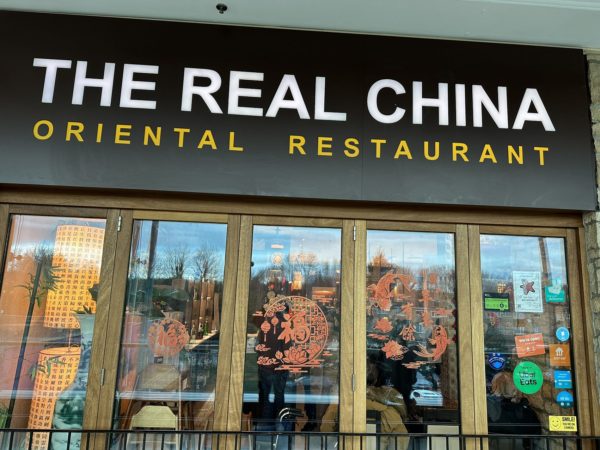
Finally, after enjoying a buffet meal at the nearby Chinese restaurant, ‘The Real China,’ we noticed an interesting phenomenon: although the restaurant’s name sounds very Chinese and mainly serves Chinese cuisine, we couldn’t find its Chinese name. Additionally, we noticed that all the staff were Indian, and it’s said that the restaurant’s owner is Chinese. This unexpected discovery added a layer of multicultural richness to our experience. It reminded us of the global nature of cuisine and culture, how food can transcend geographical and cultural boundaries to bring diverse people together.
Our team-building activity began at a restaurant named ‘The Real Greek’ and concluded at one named ‘The Real China,’ a coincidence that carries several interesting meanings or symbolic significances, adding intriguing implications to the event, such as:
- Cultural Diversity and Inclusion: The journey from a Greek to a Chinese restaurant showcases respect and appreciation for different cultures (Měirén zhīměi 美人之美 in Fei Xiaotong’s words). This may indicate that our team or organization values diversity and inclusion, willing to explore and celebrate various cultural traditions.
- A Journey from West to East: From a cultural and geographical perspective, Greece is often seen as the cradle of Western civilization, while China represents Eastern culture. The arrangement from ‘Real Greek’ to ‘Real China’ might symbolize a cultural journey from the West to the East (The mini ‘Journey to the East’ in the opposite direction of Journey to the West 与《西游记》反向的迷你“东游记”), reflecting a broad exploration of global cultural heritage.
- Exploration and Connection: Starting and ending our activity in two different but equally ‘real’ cultural venues might mean that our team values deep exploration and establishing cross-cultural connections. This experience could encourage team members to be open-minded, learning to appreciate different lifestyles and traditions (again, Měirén zhīměi 美人之美, in Fei Xiaotong’s words).
- A Culinary Journey: From a culinary standpoint, this arrangement offers a taste journey from Greek to Chinese cuisine. This not only allows team members to enjoy a diverse food experience but may also symbolize the team’s willingness to try new things and explore the unknown (Further Měirén zhīměi 美人之美, in Fei Xiaotong’s words).
- Symbolic Beginning and Ending: starting with ‘Real Greek’ and end with ‘Real China’ might have its symbolic meaning, such as beginning with the enlightenment of one culture and concluding with the wisdom of another, representing a complete cycle of growth or learning (To achieve understanding of ‘shared beauty’ Měiměi yugòng 美美与共, in Fei Xiaotong’s words).
Over two days of enriching team-building activities, our team grew not only closer to each other but also became more connected to the broad spectrum of global culture. The delicious dishes from our visits to ‘The Real Greek’ and ‘The Real China’ provided a perfect culmination to our journey, deepening our understanding of history and culture while bolstering camaraderie and satisfaction within the team. These shared experiences undoubtedly brought us closer, enriching our collective memory and fostering a greater appreciation for the diverse cultural heritage we were privileged to explore. Visiting ‘The Real China’ highlighted the beauty of transcultural encounters and opened up possibilities for appreciating the world’s diversity in unexpected ways.
Notes: Later, we met the owner of Real China and learned about some of the reforms the restaurant implemented in response to changes in clientele and staff due to the pandemic. The following is an excerpt from our sixth walking-chatting-eating route (https://globalchinaacademy.org/six-walk-talk-routes-tea-lunch-gca-centre/)
The Real China Restaurant is a chain of oriental buffet restaurants in the UK. It provides over 50 freshly prepared speciality dishes from Sezchuan, Chinese, Cantonese to Sushi and more. The modern and contemporary design of the restaurant and bar creates a great environment to dine and enjoy a cocktail with family and friends.
The Real China Restaurant at the Galleria Outlet Shopping Centre in Hatfield has undergone some reforms:
- The health and safety of customers and staff is the top priority. The floor space has been trained and redesigned to comply with current health and safety requirements.
- There is excitement about introducing the new ‘Table service buffet,’ where dishes can be ordered contactlessly using a QR code, with food delivered directly to tables.
- A new extensive menu offers more choices, with each dish freshly prepared, yet maintains the traditional Chinese buffet experience, allowing unlimited orders.
Other related events
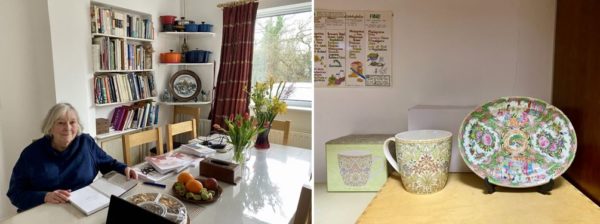
Left photo was taken on February 10th when Dr. Frances Wood signed a copy of her book Betrayed Ally: China in the Great War for Professor Xiangqun Chang. Afterwards, they enjoyed the GCA Centre’s ‘Walk and Talk’ Route 4 on Chinese New Year Day. Coincidentally, Dr. Wood brought lily flowers and a fine China mug with William Morris’s design. He was a British textile designer, poet, artist, writer, and socialist activist associated with the British Arts and Crafts movement in the 19th century. The flowers brought by LI Li from Cambridge were placed at the end of the table near the window, which had more varieties.
The right photo shows the mug and plate were displayed at the GCA Centre. Both are masterpieces of decorative art, each carrying the uniqueness of its culture and history. The mug’s colors are relatively soft, dominated by greens and yellows, complemented by delicate floral patterns. In contrast, the Canton enamel plate is more vibrant, using a variety of colors, including pink, green, yellow, and blue. William Morris’s designs are typically representative of the British Arts and Crafts movement of the late 19th century, characterized by complex natural patterns, symmetry, and repetitive botanical motifs. The Canton enamel plate reflects the artistic style of the Thirteen Hongs period in Guangdong Province, China, famous for its rich colors, complex landscapes, and symmetrical decorations. The mug might be a product of industrial pattern printing, whereas the making of the Canton enamel plate might be more complex, involving multiple firings and hand painting. The mug is a daily use item for drinking liquids; the Canton enamel plate is more likely a decorative piece or a vessel for special occasions. William Morris’s designs reflect the socio-cultural background of late 19th-century Britain, emphasizing craftsmanship and anti-industrialization. The Canton enamel plate reflects the trade prosperity and cultural exchanges of Guangdong Province during the Thirteen Hongs period.

During the Chinese New Year period, GCA received some visitors who expressed willingness to support GCA voluntarily in different ways. DOU Qing and her son from Macao (left photo), and Dr. William Zhengdong Hu (right photo), Fellow of The Sociological Review, discussed a broad range of topics within and beyond disciplinary and cross fields.

全球中国学术院两天团建活动: 融合学术洞察与文化、历史及自然探索
在紧张的筹备和成功地举办了第八届全球中国对话和全球中国学术院10年院庆的活动后,我们决定将团队建设活动安排在2024年2月初进行。我们团队由以下成员组成:常向群(全球中国学术院院长),方宏(法律顾问),郑凯蒂(行政经理),刘大卫(后勤经理),李黎和沈曦(第八届全球中国对话志愿者)。

两天团建活动的第一天安排在2月3日,在通常是人们期待着中国新年庆典的时候。然而,我们六人的团队跳出了常规,选择了考文特花园的“真正的希腊”The Real Greek进行美食探索。餐厅内摆饰着精致的花朵,增添了一抹与中国庆典中大胆的红色和金色截然不同的希腊美学。那里的氛围明显带着地中海特色,与中国新年特有的灯笼和红色装饰形成了新鲜的对比。食物被呈现在分层的托盘上,这种色彩鲜艳的菜肴摆放方式与通常放在桌中央供大家共享的中国聚餐风格形成了对比。
我们点了希腊扁面包和生蔬菜拼盘,还有包括黄色法瓦豆泥、鹰嘴豆泥、酸奶黄瓜酱、辣味羊奶酪蘸酱(Htipiti)、茄子沙拉、鸡肉串、路卡尼科牛猪混合肉肠串、猪肉串、哈洛米奶酪与蔬菜串、羊肉丸子、菠菜巨豆、炸豆丸子、烤茄子、素食肉丸子等多样的菜肴,以及地中海米饭、爱琴海卷心菜、薯条、波尔戈里小麦、新土豆和希腊沙拉等共享的配菜。甜点方面,我们共享了巴克拉瓦、橙香蛋糕和带核桃糖浆的希腊酸奶。
这些菜肴的味道丰富多样,从清爽的酸奶黄瓜酱到微辣的羊奶芝士酱,每一口都充满了惊喜。烤茄子的烟熏味与中国菜中常见的甜辣味形成了对比,而炸豆丸以其外脆内软的质感和深沉的香料味道,呈现了与中国传统炸春卷完全不同的风味。它们的各种烤串,包括鸡肉串、混合肉肠串、猪肉串和哈洛米奶酪与蔬菜串,类似于中国的羊肉串、烤鱼串、牛肉串等相似,都是将肉类或其他食材串在竹签或铁签上进行烤制。不同的是,希腊烤串在口味上更加注重香草和橄榄油的使用,而中国烧烤则更偏爱使用孜然和辣椒等调料来增加风味。地中海米饭和希腊沙拉带来了清新的口感,与我们熟悉的中国米饭和拌菜形成了鲜明的对比。巴克拉瓦的甜蜜和橙香蛋糕的柔软绵密,都是对中国节日甜食的美妙补充。
通过这些不同的口味和风格,我们的团队不仅享受到了希腊美食的独特魅力,也加深了对中西餐饮文化差异的理解和欣赏。这次视觉和美食之旅不仅为我们为第八届全球中国对话和全球中国学术院10年院庆的辛勤工作提供了必要的休息,而且还起到了文化桥梁的作用,将我们的团队与世界的多样传统相连。共享的希腊扁面包和生蔬菜拼盘,多样的蘸酱和烤串,以及各种配菜和甜点,提供了一种共同的体验,虽然在呈现上不同,但反映了中国餐饮传统中的集体欢乐。这次体验既是一次文化的沉浸,也证明了食物在将人们聚集在一起时的普遍语言。

在享受了希腊晚宴后,我们团队来到了皇家歌剧院观看芭蕾舞剧《曼侬》。皇家歌剧院位于伦敦考文特花园,是世界领先的歌剧院之一,以其卓越的歌剧和芭蕾表演而闻名。它是皇家歌剧、皇家芭蕾舞团和皇家歌剧院管弦乐团的所在地。建筑本身是维多利亚时代建筑的杰作,拥有宏伟的观众厅、豪华的公共空间和先进的舞台设施。其历史可以追溯到18世纪,使其成为英国的历史地标和文化图标。《曼侬》是由肯尼思·麦克米伦创作的三幕芭蕾舞剧,音乐由朱尔斯·马斯奈作曲。它首次由伦敦皇家芭蕾舞团于1974年上演。芭蕾舞剧基于阿贝·普雷沃1731年的小说《德·格里厄和曼侬·莱斯科的故事》。讲述了年轻而天真的曼侬爱上了骑士德·格里厄,但被她的兄弟说服离开他去追求更富有的GM先生。这部芭蕾以其表现力的编舞、情感深度和美妙的音乐而闻名,展示了舞者的才能和技术技巧。《曼侬》芭蕾舞剧和皇家歌剧院代表了西方古典表演艺术的巅峰,专注于通过舞蹈、音乐和布景设计讲述故事。
相比之下,中国在传统表演艺术领域的等价物可以认为是京剧或昆曲。京剧和昆曲体现了东方表演艺术传统的精髓,强调歌唱表演、诗意对白和象征性手势。主要区别在于用于传达故事和情感的文化表达和艺术媒介。像《曼侬》这样的西方芭蕾通常使用舞蹈的通用语言来叙述故事,而中国戏剧则采用更综合的方法,结合唱歌、表演和武术来表达复杂的叙事和角色。然而,两者都提供了对各自文化和传统的深刻见解,展示了通过表演艺术讲述故事的普遍吸引力。京剧是最著名的传统中国戏剧艺术之一,以其独特的歌曲、对白和编码的动作序列(包括手势、移动、打斗和杂技)的组合而闻名。它以精美的服装、化妆和表演者的独特声音风格而知名。昆曲被认为是中国最古老的戏曲形式之一,以其优雅的动作、精致的音乐和文学精湛而著称。这两种中国戏曲都有深厚的历史根源,并且在中国的文化遗产中扮演着重要角色,与西方文化中的芭蕾和歌剧类似。
在皇家歌剧院欣赏了《曼侬》芭蕾舞剧后,我们深深地感受到了欣赏和情感上的冲击。在这个古典艺术最负盛名的场馆之一所呈现的表演,是一次难忘的体验,与我们产生了深深的共鸣。舞者精湛的技巧,加上激动人心的音乐和关于爱与悲剧的动人叙事,将我们带入了曼侬和德·格里厄的世界,让我们亲身体验到了他们的快乐、爱恋和绝望。编舞将古典芭蕾与表现力丰富的戏剧动作相结合,捕捉了角色复杂情感和故事戏剧性转折的精髓。皇家歌剧院的宏伟和制作的华丽服装及布景为晚上增添了额外的魅力层次,让我们感觉仿佛是舞台上所描绘的奢华世界的一部分。
这次体验不仅是艺术上的享受,也是文化上的充实,提醒我们表演艺术有能力唤起深层感情并与观众进行深刻的连接。当我们离开歌剧院时,我们对表演者和创意团队所展现的才能和辛勤工作感到敬畏,同时也因芭蕾悲剧性的结局而留下了挥之不去的忧郁。然而,最重要的是,我们感到感激有机会见证如此精湛的芭蕾展示,它不仅娱乐了我们,也在情感上触动了我们,留下了对我们的心灵和思想的持久印象。
第二天,2月4日,我们的团队参观了布洛克特庄园。我们有幸与历史学家和汉学家吴芳思Frances Wood博士同行,她曾是大英图书馆中文部主任,也是全球中国学术院的信托人,还有剑桥大学菲茨威廉博物馆亚洲艺术藏品的负责人詹姆斯·林博士。在他们的知识和见解的指导下,我们走访了庄园内的几乎每一个房间,仔细观察了家具、绘画和各种收藏品。之后,我们穿过绿意盎然的田野,沿着湖泊和桥梁旁的树木漫步。

布洛克特庄园位于英格兰赫特福德郡,是一座具有数个世纪历史的经典英式乡村大宅。布洛克特庄园的建筑是帕拉第奥风格的优秀范例,其特点是对称、古典形式和宏伟规模。庄园内部同样令人印象深刻,精心装饰的房间反映了那个时代的优雅和奢华。这座壮丽的庄园曾是两位英国首相,墨尔本勋爵和帕默斯顿勋爵的居所,使其成为具有重要历史和政治意义的地点。我们探访了几乎每个房间,如维多利亚女皇的卧室,墨尔本勋爵、 墨尔本勋爵夫人,帕默斯顿勋爵、墨尔本勋爵夫人等卧室,每个房间都讲述着过去居住者及其时代的故事。布洛克特庄园以其惊人的建筑、广阔的庄园以及在英国社会和政治历史中的角色而闻名。
帕默斯顿勋爵在第一次鸦片战争期间担任英国首相,是当时的外交大臣,对启动和管理这场冲突起到了重要作用。他支持使用武力来保护英国的鸦片贸易利益,主张对中国采取强硬立场,导致了冲突的爆发。战争以中国的失败和《南京条约》的签订而结束,条约迫使中国割让香港给英国,并开放多个通商口岸,对中国产生了长期的负面影响。帕默斯顿的政策虽然扩展了英国的全球影响力,但也标志着中国近代史上一段屈辱的开始,对中国和世界历史产生了深远的影响。

庄园的花园是英国园林传统的证明,拥有广阔的田野、整齐修剪的草坪和成熟的树木,所有这些都以风景如画的湖泊和桥梁为背景。这一景观提供了宁静而田园诗般的环境,在这里可以享受悠闲的散步和英国乡村的自然美景。这片区域后来成为了以墨尔本勋爵和帕默斯顿勋爵这两位英国首相命名的两个高尔夫球场。
布洛克特庄园的园艺和历史可以与中国的古典庄园相比较,这些庄园通常根据风水原则设计,以和谐地融合建筑、园林和水元素。与布洛克特庄园相似,这些庄园曾是高级官员的居住地,是文化和政治活动的中心。中国的古典园林,如苏州的园林,因其错综复杂的设计而著名,包括亭台、池塘、假山和精心布置的植物,创造出反映传统中国文化哲学和美学理念的宁静景观。
布洛克特庄园体现了英国乡村庄园的遗产,象征着政治历史和建筑之美,而中国的古典庄园则展现了人与自然和谐相处的东方哲学,展示了园林设计的艺术和室内外空间的整合。这两种传统为我们提供了了解各自文化的窗口,强调了历史、自然和建筑在塑造这些非凡庄园的身份和遗产中的重要性。
在参观布洛克特庄园的过程中,我们深刻感受到了英国历史的厚重以及这些历史人物和地点在世界历史中的重要地位。通过吴芳思博士和詹姆斯·林博士的介绍,我们不仅对庄园的历史和建筑风格有了更加深刻的了解,还对帕默斯顿勋爵在第一次鸦片战争中的作用及其对中英关系影响有了更全面的认识。这次游历不仅是一次视觉和知识上的享受,也是一次对过去事件深层次反思和理解的机会。
庄园的自然美景和宁静氛围让我们暂时远离了现代生活的喧嚣,仿佛穿越回了那个充满历史故事的时代。在广阔的田野和湖泊旁漫步时,我们不禁思考历史的进程以及它如何塑造今天的世界。
通过这次访问,我们不仅增长了见识,也加深了对中英两国历史交流复杂性的理解。这种跨文化的学习和交流是非常宝贵的,它不仅让我们更加珍视自己的文化遗产,也促使我们对其他文化保持开放和尊重的态度。布洛克特庄园之行是一次难忘的经历,它让我们对历史的力量和美丽的自然景观有了新的认识和感悟。

最后,我们团队在附近的中餐馆“真正的中国”(The Real China)享用了自助餐,大家注意到了一个有趣的现象:尽管餐馆名字听起来很中式,里面主要是中餐,我们却找不到它的中文名字,同时注意到所有工作人员都是印度人, 据说餐馆的老板是华人。这个意外的发现为我们的体验增添了多元文化的丰富性。它提醒我们料理和文化的全球性,食物怎样能够超越地理和文化的界限,将不同的人聚集在一起。
我们的团建活动从一个名为“Real Greek”(真正的希腊)餐馆开始,最后在一个名为“Real China”(真正的中国)的餐馆结束,这种安排的巧合有几种有趣的含义或象征意义,为团建活动平添了耐人寻味的寓意,如:
- 文化多样性和包容性:从一个希腊餐馆到一个中国餐馆,这样的行程展示了对不同文化的尊重和欣赏(“美人之美”,费孝通语)。这可能意味着我们团队或组织注重多样性和包容性,愿意探索和庆祝不同的文化传统。
- 从西到东的旅程:从地理文化的角度看,希腊常被视为西方文明的摇篮,而中国则是东方文化的代表。这种从“Real Greek”到“Real China”的安排可能象征着一次从西方到东方的文化之旅,反映了对全球文化遗产的广泛探索(与《西游记》反向的迷你“东游记”)。
- 探索和连接:通过在两个不同但同样“真实”的文化场所开始和结束我们的活动,这可能意味着我们的团队重视深入探索和建立跨文化的连接。这种体验可能鼓励团队成员开放思维,学习并欣赏不同的生活方式和传统(还是“美人之美”)。
- 味觉之旅:从美食的角度来看,这种安排提供了一次从希腊菜到中国菜的味觉之旅。这不仅让团队成员能够享受到多样化的美食体验,也可能象征着团队愿意尝试新事物,勇于探索未知领域(进一步的“美人之美”)。
- 象征性的开始和结束:以“Real Greek”开始,以“Real China”结束,可能还有其象征性的意义,如从某个文化的启示开始,到另一个文化的智慧结束,代表了一次完整的成长或学习周期(达致“美美与共”,费孝通语)。
总之,在两天的丰富团建活动后,我们的团队不仅彼此间感觉更加亲密,而且对广阔的全球文化感觉更加连结。我们访问“真正的希腊”和“真正的中国”期间品尝的美味佳肴为我们的探索画上了完美的句号,加深了我们对历史和文化的理解,增强了团队间的友谊和满足感。这些共享的经历无疑让我们更加紧密地团结在一起,丰富了我们的集体记忆,并培养了我们对所探索的多元文化遗产的更大欣赏。访问“真正的中国”强调了转文化”Transculturality”的美丽以及以意想不到的方式遇见和欣赏世界多样性的可能性。
注:后来我们认识了Real China老板娘,了解到疫情以后餐厅根据客源和员工变化做的一些改革。以下引自我们的第六条徒步-聊天-吃喝路线的内容 ( https://globalchinaacademy.org/six-walk-talk-routes-tea-lunch-gca-centre).
位于哈特菲尔德的盖勒里亚奥特莱斯购物中心的真正的中国餐厅是英国的一个东方自助餐连锁餐厅。它提供超过 50 种现制特色菜,从四川菜、中餐、粤菜到寿司等。餐厅和酒吧的现代化和当代设计营造了一个适合与家人和朋友一起用餐和享受鸡尾酒的绝佳环境。近年来,他们进行了一些改革:
- 顾客和员工的健康安全是最重要的。餐厅空间已经过培训和重新设计,以符合当前的健康和安全要求。
- 他们对引入新的“桌面服务自助餐”感到兴奋,顾客可以通过扫描 QR 码无接触点餐,食物将直接送到桌上。
- 全新的扩展菜单提供更多选择,每道菜都是现做的,同时保持传统的中式自助餐体验,允许无限量点餐。
- 最重要的是,它创建了一个既有自助餐也有单点菜单的“混合餐厅”。
其他相关活动

左边的照片是2月10日拍摄的,那天是春节,吴芳思博士与常向群教授一起享受了学术院中心的“徒步与聊天”的第四条路线。之后,吴博士为常教授签署了一本她的书《被背叛的盟友:第一次世界大战中的中国》。桌上,李黎院士2月4日从剑桥带来的多样化的花(桌子尽头)还绽放着,傍边加上了这次吴博士带来的一种百合花,形成了一种对照。巧合的是,吴博士还带来了一个带有威廉·莫里斯设计的精美中国瓷杯。莫里斯是19世纪英国工艺美术运动的代表人物,他是一位纺织品设计师、诗人、艺术家、作家和社会主义活动家。这与李黎曾经捐赠给学术院的一个广彩盘又形成了一种对比。
右边的照片显示了在学术院中心展出的杯子和盘子。两者都是装饰艺术的杰作,各自承载着其文化和历史的独特性。杯子的颜色相对柔和,以绿色和黄色为主,辅以精致的花卉图案。相比之下,广彩盘则更加鲜艳,使用了多种颜色,包括粉红色、绿色、黄色和蓝色。威廉·莫里斯的设计通常代表了19世纪晚期英国工艺美术运动的风格,特点是复杂的自然图案、对称性和重复的植物纹样。广彩盘反映了广东省十三行时期的艺术风格,以其丰富的颜色、复杂的风景和对称的装饰而闻名。杯子可能是工业图案印刷的产品,而广彩盘的制作则可能更为复杂,涉及多次烧制和手工绘画。杯子是日常饮用液体的物品;广彩盘则更可能是装饰品或用于特殊场合的器皿。威廉·莫里斯的设计反映了19世纪晚期英国的社会文化背景,强调工艺和反工业化。广彩盘则反映了十三行时期广东省的贸易繁荣和文化交流。
常向群,2024年2月12日首发;3月10日更新

